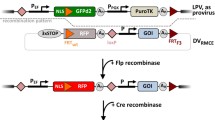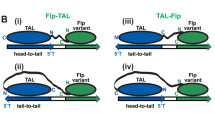Abstract
The FLP recombinase of yeast catalyses site-specific recombination between repeated FLP recombinase target (FRT) elements in yeast and in heterologous system (Escherichia coli, Drosophila, mosquito and cultured mammalian cells). In this report, it is shown that transient FLP recombinase expression can recombine and activate an extrachromosomal silent reporter gene following coinjection into fertilized one-cell mouse eggs. Furthermore, it is demonstrated that introduction of a FLP-recombinase expression vector into transgenic one-cell fertilized mouse eggs induces a recombination event at a chromosomal FRT target locus. The resulting event occured at the one-cell stage and deleted a chromosomal tandem array of a FRT containinglacZ expression cassette down to one or two copies. These results demonstrate that the FLP recombinase can be utilized to manipulate the genome of transgenic animals and suggest that FLP recombinase-mediated plasmid-to-chromosome targeting is feasible in microinjected eggs.
Similar content being viewed by others
References
Baubonis, W. and Sauer, B. (1993) Genomic targeting with purified Cre recombinase.Nuc. Acids Res. 21, 2025–9.
Bruschi, C.V. and Howe, G.A. (1988) High frequency FLP-independent homologous recombination of 2μ plasmid in the yeastSaccharomyces cerevisiae.Curr. Genet. 14, 191–99.
Cui, C., Wani, M.A., Wight, D., Kopchick, J. and Stambrook, P.J. (1994) Reporter genes in transgenic mice.Transgenic Res. 3, 182–94.
DePamphilis, M.L., Herman, S.A., Martínez-Salas, E., Chalifour, L.E., Wirak, D.O., Cupo, D.Y. and Miranda, M. (1988) Microinjecting DNA into mouse ova to study DNA replication and gene expression and to produce transgenic animals.BioTechniques 6, 662–80.
Dice, J.F. (1987) Molecular determinants of protein half-lives in eukaryotic cells.FASEB 1, 349–57.
Futcher, A.B. (1988) The 2 μm circle plasmid ofSaccharomyces cerevisae.Yeast 4, 27–40.
Golic, K.G. and Lindquist, S. (1989) The FLP recombinase of yeast catalyzes site-specific recombination in theDrosophila genome.Cell 59, 499–509.
Gu, H., Marth, J.D., Orban, P.C., Mossmann, H. and Rajewsky, K. (1994) Deletion of a DNA polymerase β gene segment in T cells using cell type-specific gene targeting.Science 265, 103–6.
Hogan, B., Costantini, F. and Lacy, E. (1986) Manipulating the Mouse Embryo: a Laboratory Manual. Cold Spring Harbor, NY: Cold Spring Harbor Laboratory Press.
Jung, S., Rajewsky, K. and Radbruch, A. (1993) Shutdown of class switch recombination by deletion of switch region control element.Science 259, 984–7.
Kilby, N.J., Snaith, M.R. and Murray, J.A.H. (1993) Site-specific recombinases: tools for genome engineering.Trends Genetics 9, 413–21.
Konosolaki, M., Sanicola, M., Kozlova, T., Liu, V., Arca, B., Savakis, C., Gelbart, W.M. and Kafatos, F.C. (1992) FLP-mediated intermolecular recombination in the cytoplasm ofDrosophila embryos.New Biol. 4, 551–7.
Lakso, M., Sauer, B., Mosinger, Jr., B., Lee, E.J., Manning, R.W., Yu, S.H., Mulder, K.W. and Westphal, H. (1992) Targeted oncogene activation by site-specific recombination in transgenic mice.Proc. Natl Acad. Sci. USA 89, 6232–6.
Ludwig, D.L. and Stringer, J.R. (1994) Spontaneous and induced homologous recombination betweenlacZ direct repeats in CV-1 cells.Som. Cell Mol. Gen. 20, 11–25.
Martinez-Salas, E., Cupo, D.Y. and DePamphilis, M.L. (1988) The need for enhancers is aquired upon formation of a diploid nucleus during early mouse development.Genes Dev. 2, 1115–26.
McBurney, M.W., Sutherland, L.C., Adra, C.N., Leclair, B., Rudnicki, M.A. and Jardine, K. (1991) The mouse Pgk-1 gene promoter contains an upstream activator sequence.Nuc. Acids. Res. 19, 5755–61.
McBurney, M.W., Staines, W.A., Boekelheide, K., Parry, D., Jardine, K. and Pickavance, L. (1994) MurinePGK-1 promoter drives widespread but not uniform expression in transgenic mice.Dev. Dynamics 200, 278–293.
McKnight, R.A., Shamay, A., Sankaran, L., Wall, R.J. and Hennighausen, L. (1992) Matrix-attachment regions can impart position-independent regulation of a tissue-specific gene in transgenic mice.Proc. Natl Acad. Sci. USA 89, 6943–7.
Morris, A.C., Schaub, T.L. and James, A.A. (1991) FLP-mediated recombination in the vector mosquito,Aedes aegypti.Nuc. Acids Res. 19, 5895–900.
O'Gorman, S., Fox, D.T. and Wahl, G.M. (1991) Recombinasemediated gene activation and site-specific integration in mammalian cells.Science 251, 1351–55.
Orban, P.C., Chui, D. and Marth, J.D. (1992) Tissue- and sitespecific DNA recombination in transgenic mice.Proc. Natl Acad. Sci. USA 89, 6861–5.
Sambrook, J., Fritsch, E.F. and Maniatis, T. (1989) Molecular Cloning: a Laboratory Manual, Second edition (Cold Spring Harbor, New York: Cold Spring Harbor Press).
Sandgren, E.P., Palmiter, R.D., Heckel, J.L., Daugherty, C.C., Brinster, R.L. and Degan, J.L. (1991) Complete hepatitic regeneration after somatic deletion of an albumin-plasminogen activator transgene.Cell 66, 245–56.
Sanes, J.R., Rubenstein, J.L.R., and Nicolas, J. (1986) Use of a recombinant retrovirus to study postimplantation cell lineage in mouse embryos.EMBO J. 5, 3133–42.
Seperack, P.K., Strobel, M.C., Corrow, D.J., Jenkins, N.A., and Copeland, N.G. (1988) Somatic and germ-line reverse mutation rates of the retrovirus-induced dilue coat color mutation of DBA mice.Proc. Natl Acad. Sci USA 85, 189–192.
Wilkie, T.M., Braun, R.E., Ehrman, W.J., Palmiter, R.D., and Hammer, R.E. (1991) Germline intrachromosomal recombination restores fertility in transgenic MyK-103 male mice.Genes Dev. 5, 38–48.
Author information
Authors and Affiliations
Rights and permissions
About this article
Cite this article
Ludwig, D.L., Stringer, J.R., Wight, D.C. et al. FLP-mediated site-specific recombination in microinjected murine zygotes. Transgenic Research 5, 385–395 (1996). https://doi.org/10.1007/BF01980203
Received:
Revised:
Accepted:
Issue Date:
DOI: https://doi.org/10.1007/BF01980203




